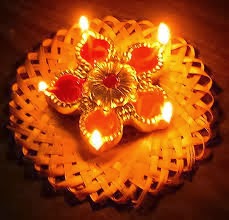Festivals celebrated by people from all religions have some inner spiritual significance. The true purpose of celebrating these festivals is to understand and remind ourselves of the inner spiritual significance even as we perform and participate in the prescribed outer rituals. However, more often than not, we miss the wood for the trees. We get so lost in the rituals and even distort the rituals to suit our convenience and cater to our taste that the underlying spiritual significance is pushed to the back burner.
In this post, Bhagawan explains to us the inner spiritual significance of the festival of Diwali (Deepaavali) or the festival of lights as it is commonly known. The festival of Diwali primarily signifies the victory of light over dark forces. In a Discourse in 1966, Bhagawan says, “When Narakaasura was destroyed, that is to say, when the six foes of man (Kama-desire, Krodha-anger, Lobha-greed, Moha-attachment, Mada-pride, Matsarya-jealousy), which drag him towards a fall, are overpowered, then the flame of wisdom can shine clear and bright. It is in order to demonstrate this that on the Deepaavali day, lamps are lit and arranged in every house, dispelling darkness, which is the home of evil and vice. Sathya or truth will defeat the forces of falsehood. That is the meaning of Sathyabhama being the instrument, which the Lord used to destroy Narakaasura”.
The audio clips in this posting have been taken from three Discourses. The six audio clips have been taken from the Discourses delivered by Bhagawan in the years 1988, 1992 and 2002.
In Clip-1 Bhagawan explains why the day before the day of Diwali is called Narakachaturdasi. In Clip-2 He goes on to highlight the meaning of the name Narakaasura, which externally meant the name of the demon but internally has a greater significance. Clip-3 explains the significance of the destruction of the demon Narakaasura. Clip-4 tells us why lamps are lit on the day of Deepaavali. Clip-5 throws light on the symbolism of lighting many lamps from one lamp. Finally, Clip-5 gives the inner significance of bursting crackers during the festival of Diwali.
Each audio clip has a name that adopts the following code: Serial number, Title appropriate to the key content, Duration of the clip, Year-Month-Date of the Clip. Below the title is the translation in English of the select excerpt of the Discourse, followed by the audio player. The post ends with a short quiz that would help you evaluate your assimilation of Bhagawan’s Message from these extracts.
Note: Those receiving this blog by email may see words bunched together due to a technical glitch. That is beyond my control. Please click on link at the top of the email to read the blog directly. Sorry about this. If anyone has a solution to this please help me out.
01-The Killing of Narakaasura-The day is called Narakachaturdasi-2.48-1988 November 09
 |
| Slaying of Narakaasura |
When we look into the history, we find that Narakaasura is an evil and wicked person. In that kingdom there were no lights on any day, either in the Bazaar or in the houses. In that kingdom no one could see any women move about. The women had never seen any lit lamps at all. Narakaasura was such an evil person. He brought a number of princes, women and young girls, imprisoned them and subjected them to a lot of suffering. Not able to bear this suffering, many of them prayed to Krishna. They prayed to Him to kill this demon who had taken birth to destroy the very humanness of mankind and to thus save their lives and bring about welfare of humanity.
He had to be killed by the ones whom he caused most suffering to. The one who has taken to the sword has to be killed by that very sword itself. The one who behaves with bad qualities will be troubled by those very same bad qualities. Therefore, in the same way, being an evil person who caused so much suffering to the women, he (Narakaasura) had to killed by a woman alone. It is in this context that Krishna took Satyabhama along with Him and put an end to Narakaasura. The day Narakaasura was killed was a Chaturdasi (14th day of the waning phase of the moon). This day is therefore called Narakachaturdasi.
02-Meaning of the name Narakaasura-1.58-1992 October 24
We must understand the inner meaning of the word “Nara”. “Raha” means destruction. “Na’ means no. Therefore, the one that cannot be destroyed is “Nara” or man. What is the meaning of man who cannot be destroyed? It means “Amrutasya Putrah”. The Upanishads addressed the man as “Shrunvantu Vishwe Amrutasya Putrah” (Shvetaashvatara Upanishad – 2.5). They addressed man as, “O sons of immortality”.
When the letter “Ka” is added to such a Nara (man), it gets transformed into Naraka. Naratva (one with human quality) is the one that goes to heaven. Narakatva (one with demonic quality) is the one that goes to hell. Thus the demonic quality makes man forget his Divinity and takes him towards hell. Naraka is an Asura (demon). Atma is Divinity. Though the Atmic principle exists in man, it is not possible to recognize it so clearly.
03-Destruction of Narakaasura symbolizes the killing of the demon in man-1.52-2002 November 04
 |
| Killing the demon in man |
Students, today is the day Narakaasura was killed. That means, the killing of the demon in the Atma. Nara is Atma. Asura is demon. The demon is in every heart. We do not have to go anywhere and earn any special weapon to kill this demon. In our own heart, there is the Nara, who is the Atmaswaroopa (the form of the Atma). Keep thinking about the Atmaswaroopa(the Self), that is Premaswaroopa(the form of Love). That is the true, eternal principle. With such Love, the demon can be killed. To kill this demon, you do not need any other great weapon. This demon will not be killed through any weapon or arms. Love alone can overpower him. There are so many weapons in this world. But what can you do with them? Nothing can be done. One hurts himself by using these weapons. Therefore, the Atmic principle within man is the only one who can kill Narakaasura. When you foster the principle of Atma, this Naraka will die. True devotion is the recognition and practice of this Truth.
04-Inner Significance of Lighting Lamps on the day of Narakachaturdasi-1.17-1988 November 09
 |
| Festival of lights |
As this is the day to experience happiness, lamps are lit to make the whole world shine with brilliance. The women in the captivity of Narakaasura had never seen the light of the day at all. Only when they were freed from his bondage, they started seeing the light of the day, the light of the lamps. They started lighting lamps.
Therefore, so long as the demon of bad qualities exists within us, there will be darkness only. We must distance this bad power. We must kill the bad feelings. We must light the Divinity in us. We must live a sacred life. Narakachaturdasiday is the day that teaches these lessons of inner significance to us.
05-Significance of Lighting many lamps from one Lamp-1.31-1988 November 09
 |
| One to Many |
There is one more point. Recognizing the Vedic dictum “Ekoham Bahusyaam” (The One manifested as the Many), we light the lamps. We decorate the place with so many lamps. First we light one lamp and then we light all other lamps using this one lamp. It is just one lamp that lights a thousand lamps. That one lamp has lighted many lamps. That one Jyothi(light) is the Paramjyothi (supreme soul). The rest are Jeevanajyothis(individual souls). This one Paramajyothihas lit all the Jeevanajyothis. Ekoham Bahusyaam – the one light has manifested as many. The Deepaavali day conveys this spiritual message.
06-Inner Significance of Bursting Crackers on Narakachaturdasi and Deepaavali-0.48-1988 November 09
 |
| Bursting crackers |
With joy and enthusiasm of having reached this pure state (of being freed from Narakaasura) the crackers are burst. The sound emanating from these crackers resemble the sound at the time of slaying Narakaasura. When every cracker makes a sound, the 16000 Gopikas experienced great happiness, feeling that, “O Krishna has slayed the head of that demon”. All these sounds were taken as a symbol of the killing of Narakaasura.
A Short Quiz
01-Why did Krishna not kill Narakaasura Himself? Why did He take Satyabhama to kill Narakaasura?
02- What is the meaning of the word “Nara” i.e. man?
03- From which Upanishad is this phrase taken – Shrunvantu Vishwe Amrutasya Putrah?
04-What is the inner meaning of killing the demon Narakaasura? What is the weapon to be used to kill him?
05-Why are lamps lit on the day of Narakachaturdasi and Deepaavali?
06-What is the inner significance of lighting the lamps?
07-How is the message of Ekoham Bahusyaam communicated through the lighting of lamps?
08-What do the bursting of crackers during Deepaavali symbolize?







